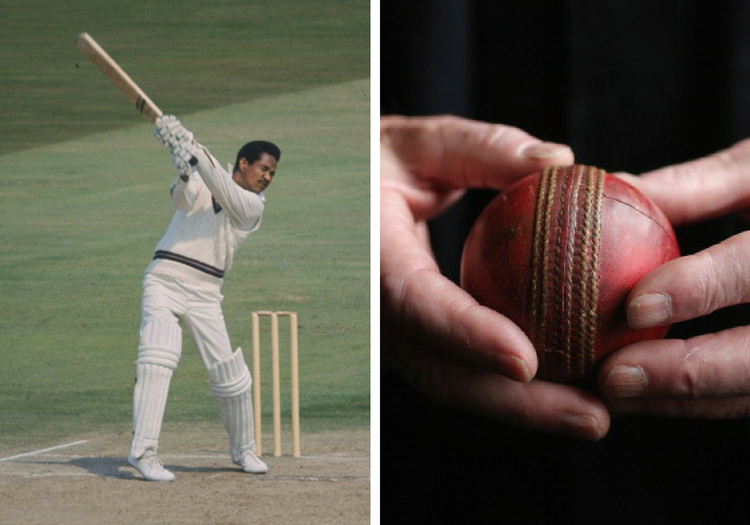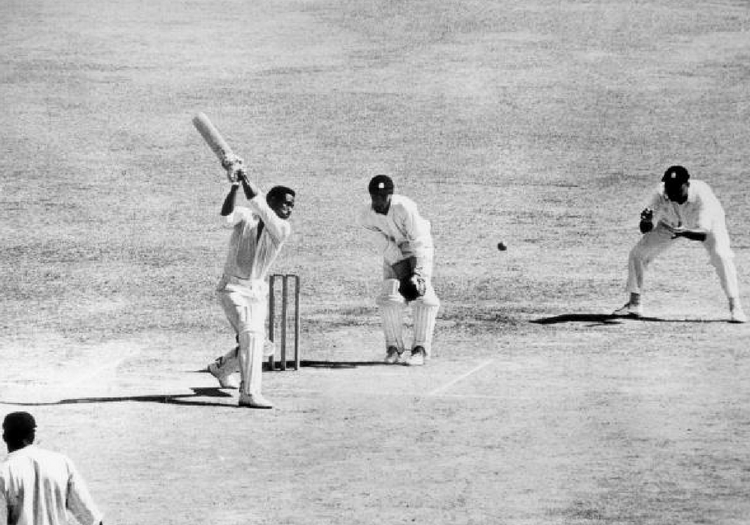SIMON HUGHES: I thought the best way to bowl and get him out was to keep pitching it up and let him have a go at it and hope he whacks it up in the air," Malcolm Nash remembers. "And that’s exactly what he did, except he didn’t whack it too short!

Sir Garfield Sobers and, right, the ball with which he hit six sixes
There are three landmark performances in the history of cricket. Brian Lara’s 501 not out at Edgbaston 1994, Jim Laker’s 19 for 90 at Old Trafford in 1956, and Sir Garfield Sobers’ six sixes off an over at Swansea in 1968.
None, you would imagine, would ever be bettered. It is hard to imagine a batsman having the time and relentless scoring ability to exceed Lara’s achievement, or to have the conditions, skill and luck (in the sense of only one wicket in two innings falling to another bowler) to even equal Laker’s feat. There are only two instances of a bowler taking 18 wickets in a match – in 1837 and 1861.
In the era of free hits for a no-ball, Sobers’ achievement could theoretically be overtaken, and actually was in a match in New Zealand in 1989/90 when Wellington’s Robert Vance deliberately conceded 77 off an over containing 17 no-balls. But Sobers was the first to attain the maximum possible runs off six legal deliveries – from Malcolm Nash – without ‘help’ from the fielding side.
It is a feat only once since equalled in first-class cricket, by Ravi Shastri in 1984/85. And the legitimacy of Sobers’ performance, 50 years ago this August, is confirmed when you hear the two protagonists’ stories.

Sobers achieved the feat in 1968
Come August bank holiday weekend, Notts were lying in fifth spot, with one match to go. This was against Glamorgan at St Helen’s, Swansea. I sat in the seats with Nash reliving that first day. Sobers had been Nash’s hero as a boy. He was not just the best player in the world but he was also left-handed, like Nash, and able to instantly convert from seam to spin, which had convinced the Glamorgan allrounder to be similarly versatile.
“Notts had reached a commanding 358 for 5 by 5pm on the first day,” Nash recalls, “but I had four of the five wickets to fall using my two styles and was bowling well. Garry was on about 40 not out. I had got his wicket a couple of times before, and as they were now seeking quick runs before a declaration, I thought I could do so again.”
Sobers said: “That day in Swansea we had a good score and I had scored a few, and I decided now we need real quick runs and it doesn’t matter if I get out. So I thought I would take the Learie Constantine route. And Malcolm Nash was bowling. We were good friends and he always believed he could get me out. And there was a little short boundary on the leg side.”
I had forgotten how short until walking across the St Helen’s outfield. From the left side of the square where that pitch was located it was barely a chip for six over midwicket. “Actually it was only a half-chip,” Nash said. “If they brought the boundaries in it would have been an under-13 pitch. But we’ve played cricket here since 1921 so it’s OK. And I’ve hit a few sixes here myself, of course!
“The first ball I bowled to Garry after tea – left-arm spin, around the wicket – wasn’t a bad ball, on a length on the stumps,” Nash continues. “He hit it straight up there. Over long-on. It went out of the ground and hit the guttering on The Cricketers.”

Sobers hit Malcolm Nash for six sixes in Swansea
He indicates the dilapidated pub beyond the ground’s walls. “I thought ‘Oh, crikey’. But I also thought the best way to bowl and get him out was to keep pitching it up and let him have a go at it and hope that he whacks it up in the air. And that’s exactly what he did, except he didn’t whack it too short! He put the next one over square leg and it bounced into the road.
"Then the third landed up here, over long-off. I thought, ‘That went into orbit, pretty much’. The lads were getting further and further away from me, except that I still had a slip. I don’t know why. The next one went miles over midwicket. He played everything off the back foot. I thought ‘OK, but he’s going to mishit one in a minute’.”
It was an optimistic thought. Looking on YouTube at the height of Sobers’ backlift and the velocity of his follow-through that day, throwing every available muscle and tendon into the shot, it was hard to see even a mishit being caught. It looked like he was batting in the last over of a T20 match.
“I always had a big backlift,” Sobers says. “It came from learning to play with a tennis ball and having to hit it as hard as you could or it wouldn’t go anywhere. That day I thought, if I mishit it’s going to be very high and the fielder might get tired waiting to catch it!”
In fact Nash’s optimism almost paid off: “I gave the fifth one a little bit more air. He got underneath it a bit more. Roger Davis was at long-off on the line, just in front of us here. He got his hands ready and took the catch but then he overbalanced and sat down on the line. There were members shouting ‘out’ and there were members shouting ‘six’. The umpires had a consultation.”
“I started to walk,” Sobers says, “and the crowd were all Glamorgan fans, of course, but a lot of them said ‘you’re not out, go back’. They wanted to see if I could hit the sixth for six.” The umpire Eddie Philipson eventually signalled six. “There had been nothing in my mind about the six sixes through the over. But I thought – the last ball – this has got to go. I don’t care where Malcolm bowls it, it is going for six. I knew he was going to try to trick me and bowl the quick one.”
That is one of the hallmarks of the truly great batsmen. They seem to instinctively know where the ball will be. Sobers had read the bowler’s mind well. “There was one ball to go,” Nash reflects. “Tony Lewis says people kept coming up and having a word to me, but actually no one said anything. There was no one close enough!
“I bowled a seamer, from round the wicket off a short run. Something I’d never done before. And it was the worst ball of the day, never mind the over. And that disappeared over midwicket onto the road between those two buildings.

It was the first such incident in first-class cricket
"It ended up at a bus stop way, way down the road and this little lad picked the ball up, took it home and brought it back the next day and it was on the national news. And there was such a long time afterwards trying to find another ball from the dressing room that Garry said, ‘right that’s it I’ve had enough’, and he declared.”
How did Nash feel afterwards? “I was a little shaky at first. But it didn’t register that this was the first time it had ever happened. The other players were reminding me of it, of course. OK, so it’s happened and it’s unfortunate that it’s me. But it never affected my psyche then and it still doesn’t now."
The magnitude of Sobers’ achievement is that only three times in half a century since has the feat been repeated – by Shastri, Herschelle Gibbs (for South Africa in an ODI against the Netherlands), Yuvraj Singh (off Stuart Broad in the 2007 World Twenty20 at Durban) and Ross Whiteley of Worcestershire.
That day at Swansea was 10 minutes of mayhem that confirmed one man’s supernatural status and raised another out of anonymity. Paradoxically the latter’s story is actually more interesting than the former’s.
This is an extract of an article which originally appeared in the July edition of The Cricketer. Click here for subscriptions
Not Only, But Also: My Life in Cricket by Malcolm Nash and Richard Bentley; PB, 224pp, St David’s Press